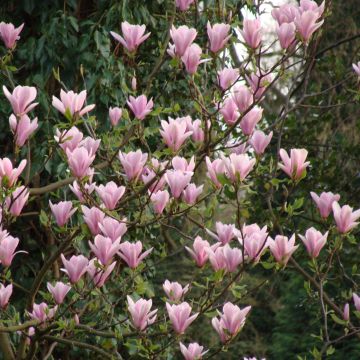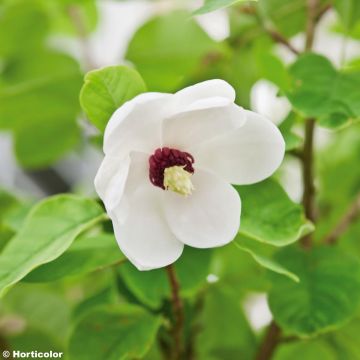

Magnolia officinalis biloba - Magnolia officinal


Magnolia officinalis biloba - Magnolia officinal


Magnolia officinalis biloba - Magnolia officinal
Magnolia officinalis var. biloba
Magnolia officinalis var. biloba
Magnolia
Special offer!
Receive a €20 voucher for any order over €90 (excluding delivery costs, credit notes, and plastic-free options)!
1- Add your favorite plants to your cart.
2- Once you have reached €90, confirm your order (you can even choose the delivery date!).
3- As soon as your order is shipped, you will receive an email containing your voucher code, valid for 3 months (90 days).
Your voucher is unique and can only be used once, for any order with a minimum value of €20, excluding delivery costs.
Can be combined with other current offers, non-divisible and non-refundable.
Why not try an alternative variety in stock?
View all →This plant carries a 24 months recovery warranty
More information
We guarantee the quality of our plants for a full growing cycle, and will replace at our expense any plant that fails to recover under normal climatic and planting conditions.
Would this plant suit my garden?
Set up your Plantfit profile →
Description
The Magnolia officinalis var. biloba is a spectacular ornamental bush, with an exotic charm. First, we admire its immense leaves assembled in rosettes, before witnessing the blooming of the flowers, after 8 to 10 years of cultivation. But the sight of its large cream-colored goblets, whose sweet fragrance fills the air in late spring, deserves all the patience of the gardener. Although not widely planted in Western gardens, it is no more difficult to grow than a large rhododendron. More cold-resistant, it simply requires a deep and loose soil, remaining moist and neutral to acidic.
Within the magnolia family, the Magnolia officinalis is one of the most beautiful species. It is a robust bush with an elegant habit, deciduous, perfectly hardy, often many-stemmed, developing a regular and lightly branched crown, generally conical, rounding with age. The biloba subspecies differs only in the shape of its leaves, which have two lobes at their truncate end. Native to China, it is highly appreciated there for its medicinal properties.
In our gardens, the Magnolia officinalis var. biloba generally reaches a height of 8-10 m (26-33ft) with a spread of 5-6 m. Its growth is quite fast once well established. Its bark is brown to ashy gray, thick and wrinkled, but does not crack with age. It becomes scaly at the base of the trunk on mature subjects. The young branches are covered with short, soft hairs. In spring, the large buds open into immense leaves, wide obovate, measuring up to 50 cm (20 in) in length and 25 cm (10 in) in width. The upper surface of the leaf is a tender green with a satin finish, strongly veined. The leaves are arranged in whorls at the ends of the branches. Flowering takes place from May to June, depending on the climate, in the form of cream-white flowers sometimes reaching 20 cm (8in) in diameter. They are composed of 9 to 12 cream-colored petals. The base of the stamens is tinged with red. The flowers exhale a pronounced and pleasant, fruity scent, typical of magnolia flowers. They give way to red-pink fruits, gathered in decorative cones measuring 10 to 13 cm (4 to 5 in) in length. They also contain red seeds. Before falling, the foliage takes on beautiful brick-brown hues.
This Magnolia, magnificent in foliage and flowers, will work wonders in both a medium-sized garden and a large park! It is most often used as a solitary plant in the middle of a short grass meadow or towering over a lower shrub border. It pairs well with the flamboyant flowers of rhododendrons and deciduous azaleas that appreciate the same environments. Beautiful trees like Henry's Lime (Tilia henryana) will accompany it during its flowering. The Caramel Tree (Cercidiphyllum japonicum) or the Persian Parrotia (Parrotia persica) will enhance its foliage with magnificent autumn colors.
Report an error about the product description
Magnolia officinalis var. biloba in pictures




Plant habit
Flowering
Foliage
Botanical data
Magnolia
officinalis
var. biloba
Magnoliaceae
Magnolia
China
Other Magnolia
View all →Planting and care
Magnolia officinalis var. biloba prefers sunny to partially shaded exposures, it requires a deep, moist soil in summer, fertile and humus-rich, without limestone. It is hardy up to -17°C (1.4°F). Planting of the Magnolia can be done in spring or autumn, outside the freezing period. Provide a hole 80 cm (32 in) wide and equally deep with a good supply of ericaceous compost if your soil tends to be clayey and slightly limestone. Be careful when planting it in the hole, to avoid breaking the roots which are fleshy but quite fragile. Immediate watering with lime-free water (rainwater) helps to settle the soil around the roots. During the first year of planting, the Magnolia requires one watering can per week. It will appreciate a good mulch once a year in spring. The Magnolia does not like prolonged drought, so the soil must remain moist (but not waterlogged) throughout the summer. It is recommended to mulch its base to keep it moist during the hot season, enrich its soil, and protect it from the cold in winter. Since its roots are fragile, it is best not to transplant it. The only enemies of the Magnolia are pests such as scale insects, snails, and slugs that attack young plants, and diseases such as rot (in overly waterlogged soil) and coral disease.
Planting period
Intended location
Care
This item has not been reviewed yet - be the first to leave a review about it.
Similar products
Haven't found what you were looking for?
Hardiness is the lowest winter temperature a plant can endure without suffering serious damage or even dying. However, hardiness is affected by location (a sheltered area, such as a patio), protection (winter cover) and soil type (hardiness is improved by well-drained soil).

Photo Sharing Terms & Conditions
In order to encourage gardeners to interact and share their experiences, Promesse de fleurs offers various media enabling content to be uploaded onto its Site - in particular via the ‘Photo sharing’ module.
The User agrees to refrain from:
- Posting any content that is illegal, prejudicial, insulting, racist, inciteful to hatred, revisionist, contrary to public decency, that infringes on privacy or on the privacy rights of third parties, in particular the publicity rights of persons and goods, intellectual property rights, or the right to privacy.
- Submitting content on behalf of a third party;
- Impersonate the identity of a third party and/or publish any personal information about a third party;
In general, the User undertakes to refrain from any unethical behaviour.
All Content (in particular text, comments, files, images, photos, videos, creative works, etc.), which may be subject to property or intellectual property rights, image or other private rights, shall remain the property of the User, subject to the limited rights granted by the terms of the licence granted by Promesse de fleurs as stated below. Users are at liberty to publish or not to publish such Content on the Site, notably via the ‘Photo Sharing’ facility, and accept that this Content shall be made public and freely accessible, notably on the Internet.
Users further acknowledge, undertake to have ,and guarantee that they hold all necessary rights and permissions to publish such material on the Site, in particular with regard to the legislation in force pertaining to any privacy, property, intellectual property, image, or contractual rights, or rights of any other nature. By publishing such Content on the Site, Users acknowledge accepting full liability as publishers of the Content within the meaning of the law, and grant Promesse de fleurs, free of charge, an inclusive, worldwide licence for the said Content for the entire duration of its publication, including all reproduction, representation, up/downloading, displaying, performing, transmission, and storage rights.
Users also grant permission for their name to be linked to the Content and accept that this link may not always be made available.
By engaging in posting material, Users consent to their Content becoming automatically accessible on the Internet, in particular on other sites and/or blogs and/or web pages of the Promesse de fleurs site, including in particular social pages and the Promesse de fleurs catalogue.
Users may secure the removal of entrusted content free of charge by issuing a simple request via our contact form.
The flowering period indicated on our website applies to countries and regions located in USDA zone 8 (France, the United Kingdom, Ireland, the Netherlands, etc.)
It will vary according to where you live:
- In zones 9 to 10 (Italy, Spain, Greece, etc.), flowering will occur about 2 to 4 weeks earlier.
- In zones 6 to 7 (Germany, Poland, Slovenia, and lower mountainous regions), flowering will be delayed by 2 to 3 weeks.
- In zone 5 (Central Europe, Scandinavia), blooming will be delayed by 3 to 5 weeks.
In temperate climates, pruning of spring-flowering shrubs (forsythia, spireas, etc.) should be done just after flowering.
Pruning of summer-flowering shrubs (Indian Lilac, Perovskia, etc.) can be done in winter or spring.
In cold regions as well as with frost-sensitive plants, avoid pruning too early when severe frosts may still occur.
The planting period indicated on our website applies to countries and regions located in USDA zone 8 (France, United Kingdom, Ireland, Netherlands).
It will vary according to where you live:
- In Mediterranean zones (Marseille, Madrid, Milan, etc.), autumn and winter are the best planting periods.
- In continental zones (Strasbourg, Munich, Vienna, etc.), delay planting by 2 to 3 weeks in spring and bring it forward by 2 to 4 weeks in autumn.
- In mountainous regions (the Alps, Pyrenees, Carpathians, etc.), it is best to plant in late spring (May-June) or late summer (August-September).
The harvesting period indicated on our website applies to countries and regions in USDA zone 8 (France, England, Ireland, the Netherlands).
In colder areas (Scandinavia, Poland, Austria...) fruit and vegetable harvests are likely to be delayed by 3-4 weeks.
In warmer areas (Italy, Spain, Greece, etc.), harvesting will probably take place earlier, depending on weather conditions.
The sowing periods indicated on our website apply to countries and regions within USDA Zone 8 (France, UK, Ireland, Netherlands).
In colder areas (Scandinavia, Poland, Austria...), delay any outdoor sowing by 3-4 weeks, or sow under glass.
In warmer climes (Italy, Spain, Greece, etc.), bring outdoor sowing forward by a few weeks.



























































